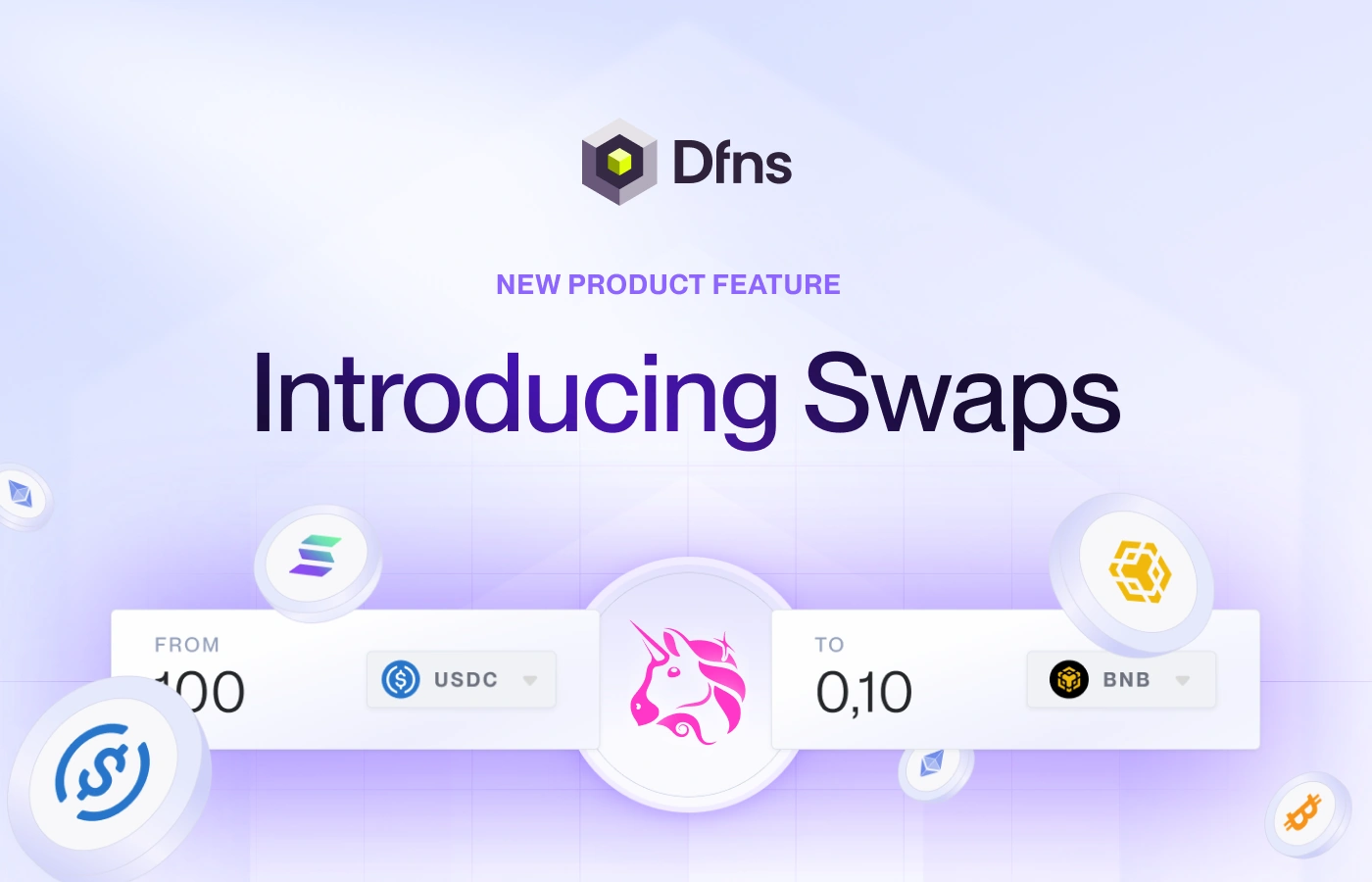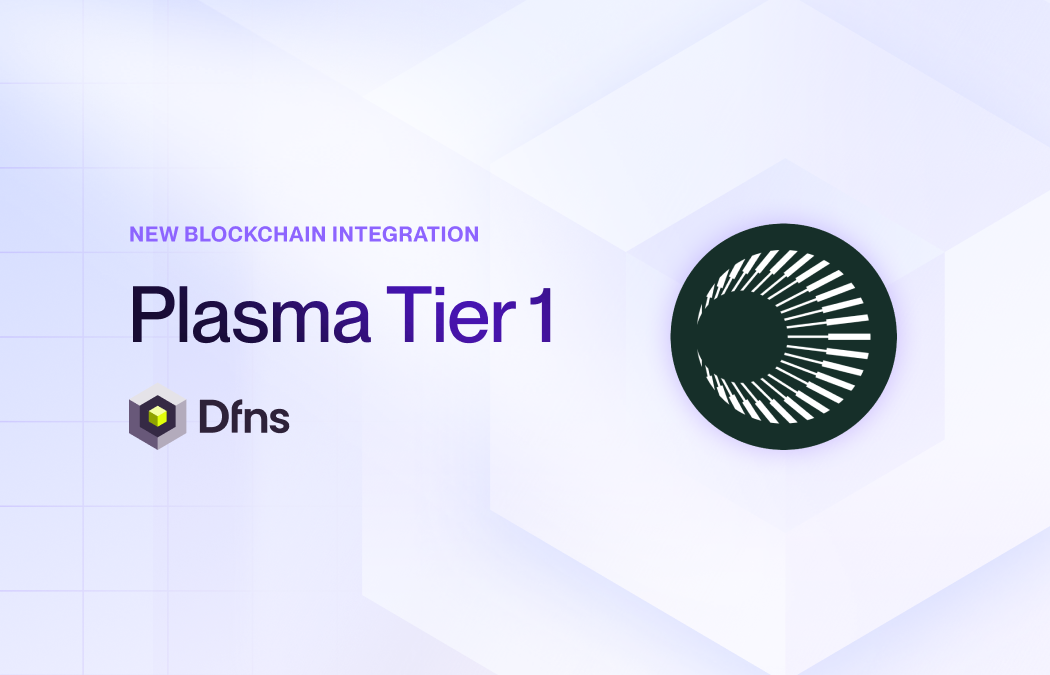
Dfns launches Swaps to enable automatic crypto conversions.
Today we’re launching Swaps, a new UI that makes token conversions a built-in feature of the Dfns wallet platform. We’re starting with a direct integration of Uniswap Trading API, the leading decentralized exchange on Ethereum, allowing onchain token swaps across all supported EVM chains.
Swaps are now a first-class feature in Dfns. They’re fully traceable, and available through the same dashboard you already use for transactions and policies. Instead of handling swaps as a separate tool, Dfns brings them into its core wallet system, supporting use cases like stablecoin rebalancing, client withdrawals, or in-app asset conversion. Everything happens through a single, secure UI. No need for external integrations, scattered tools, or manual steps. From quote to execution, the entire process is automated, auditable, and built for reliability.
Embed swaps into your transaction lifecycle
Until now, institutions had to use separate tools to swap tokens, which added complexity and risk. With this new integration, swaps can be quoted, executed, and tracked directly through Dfns across all supported EVM chains. The Uniswap Trading API offers reliability, strong liquidity, and broad token support on Arbitrum, Avalanche, Base, Blast, BNB Chain, Celo, Ethereum, Optimism, Polygon, Solana, Unichain, World Chain, Zora Network, and ZKsync.
Swaps run entirely through Dfns. The Uniswap Trading API integration supports Uniswap v2, v3, v4, and UniswapX. Dfns manages all ERC20 approvals, signing, and interactions with the Trading API. This turns swaps into simple, programmable operations that plug directly into your treasury and asset management flows.
UniswapX brings an additional layer of innovation to this flow. It’s an open-source, auction-based routing protocol designed to aggregate liquidity across AMMs and other venues, while protecting traders against MEV and failed transaction costs. With UniswapX, swaps can even be executed gas-free, and the roadmap includes cross-chain swaps in the coming months. By supporting UniswapX alongside Uniswap v2, v3, and v4, Dfns ensures institutions benefit from the best available pricing, broader execution strategies, and future-proof swap infrastructure.
Here’s how it works:
- Search: Choose the tokens you want to swap by name or symbol.
- Quote: See the expected output and rate instantly.
- Review: Set your slippage tolerance and review final amounts.
- Sign and Execute: Dfns handles all approvals, signing, and transaction validation.
Once submitted, the swap is tracked from start to finish. You get full visibility into its progress, transaction details, and audit trail.
Why we started with the Uniswap Trading API
We chose start swap integration by partnering with Uniswap Labs for good reason: their Trading API infrastructure offers seamless onchain trading and allows our institutional clients to adopt swapping functionality fast, with deep onchain liquidity. From both an admin and end-user perspective, this integration offers the most seamless entry point to token swaps
- No need to manage counterparty risk
- No off-chain settlement or reconciliation
- No exposure to custodial delays or withdrawal limits
How the Swaps UI works with Uniswap
Swaps in Dfns follow a two-step flow: quoting, then execution. This separation allows users to preview transactions before committing and gives product teams flexibility to add swaps into complex workflows.
- Get a quote. To start a swap, you first request a quote for a given source and target asset pair, with slippage tolerance and wallet context. This call returns the estimated output amount, execution route, and a quoteId. The quote remains valid for a limited time window.
- Execute the swap. If the quote is acceptable, the next step is to confirm the intent to swap by referencing the quoteId. This creates a swap intent, which persists the transaction context and triggers the execution process.
Once the swap intent is created, Dfns takes care of the entire execution flow using a checklist logic depending on if the liquidity will be sourced from the Uniswap Protocol or UniswapX and whether the wallet has already approved the ERC20 token. Here’s how Dfns uses the Uniswap Trading API to make swaps safe, composable, and policy-compliant:
- Request a quote for any two tokens by name or contract address. The request includes:
- Source token, destination token
- Swap amount
- Slippage tolerance
- Wallet context (from which the swap originates)
- In return, Dfns provides:
- Output token amount
- Optimized execution route
- quoteId (used for the next step)
- Execute the swap. To execute the swap, simply reference the quoteId. Dfns will:
- Check ERC20 allowance and approve if needed
- Build and sign the swap transaction
- Submit it onchain (via Uniswap v2, v3, v4, or UniswapX)
- Monitor its status end-to-end
- Provide traceable transaction data and audit history
This separation of quote vs. execution gives you programmatic control over the timing and conditions of each trade. It allows users to preview transactions before committing and gives product teams flexibility to integrate swaps into more complex workflows.
From simple swaps to full-stack liquidity
Swaps are a key tool for automating and securing treasury operations in institutional finance. We’ve seen them used for all sorts of tasks, like rebalancing between USDC and EURC to manage liquidity, handling client withdrawals by converting assets on the fly, swapping stablecoins into native tokens for on/off-ramp flows, enabling in-app token conversions for users, or adjusting token balances for staking, lending, and collateral needs.
Our first release focuses on crypto-to-crypto swaps, starting with the Uniswap Trading API integration. We’re already working on broader support to cover more of your financial operations. Coming next:
- Crypto to fiat swaps: Connect with payment processors and banks to convert crypto to fiat (and back), with built-in KYC/KYB.
- Cross-ecosystem swaps: Move assets between ecosystems like Solana, Aptos, or Cosmos using trusted bridge providers.
- Policy-based swaps: Set rules, limits, and approval steps to give treasury teams control while automating safely.
- Automation triggers: Run swaps automatically based on balance levels, price movements, or time schedules, making advanced workflows easy to set up.
Token swaps are now just a button click away
The Swaps UI is available today for selected dashboard users who want to integrate token swaps into backend systems, in-app flows, or treasury automations. This makes token swaps a smooth, policy-based workflow. It hides the technical complexity while keeping full control. With liquidity pools built into your wallet infrastructure, Dfns helps you manage token conversion easily across a range of use cases like rebalancing stablecoin reserves, converting tokens for settlement, supporting withdrawals in preferred assets, or enabling in-app trading. API access for Swaps is coming soon, giving developers the ability to embed token conversion directly into their applications and automated workflows.
To get started with Swaps, visit the Dfns Dashboard and contact our team for access.






